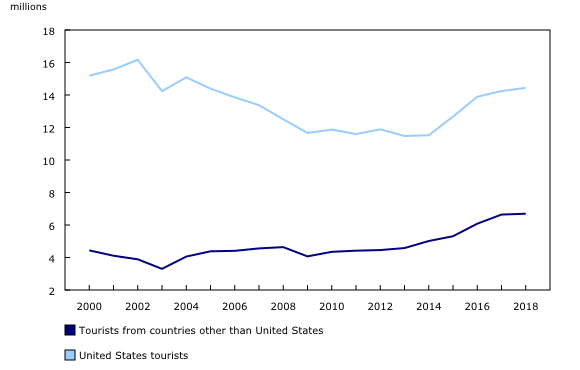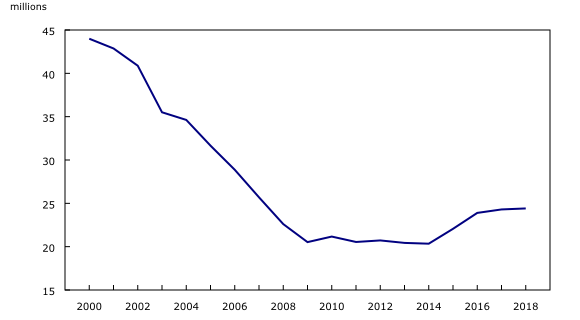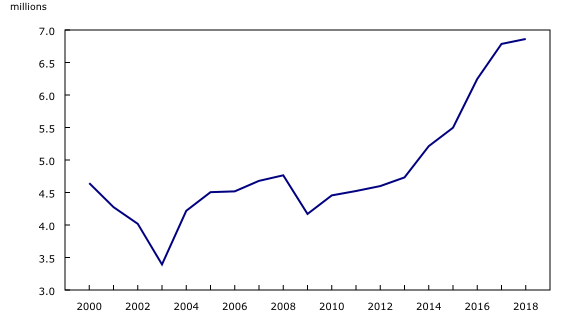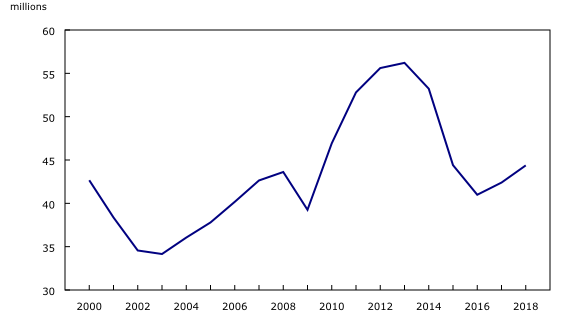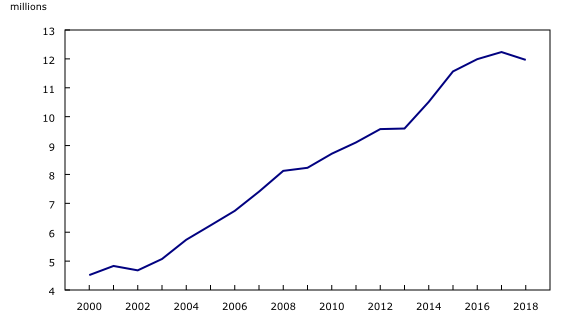Travel between Canada and other countries, December 2018
Archived Content
Information identified as archived is provided for reference, research or recordkeeping purposes. It is not subject to the Government of Canada Web Standards and has not been altered or updated since it was archived. Please "contact us" to request a format other than those available.
Released: 2019-02-21
Year-end review, 2018
Record number of tourists from abroad arrived in Canada in 2018
Canada received 21.1 million international tourists from abroad in 2018, the highest number on record and up 1.2% from the previous record of 20.9 million in 2017, the year of the country's 150th birthday celebrations. This was the fifth consecutive year of growth for international tourist arrivals in Canada and the first year since 2015 that growth in numbers of tourists from the United States (+1.4%) outpaced the increase from overseas countries (+0.8%).
The following analysis focuses on 2018 annual totals for tourists and travellers. International tourists are those making overnight trips, whereas travellers include both same-day and overnight visits. The majority of same-day trips involve Canadian or US residents making trips by car across the Canada-US border.
Tourists
In recent years, the numbers of international tourists visiting Canada has returned to levels last seen during the early 2000s, after which the number of visitors to Canada declined. A number of factors influenced this decline, such as the SARS (severe acute respiratory syndrome) outbreak in 2003, the appreciation of the Canadian dollar from 2002 to 2008, and the global recession in 2008/2009. During that period, the number of international tourists to Canada had declined from a high of 20.1 million in 2002 to 15.7 million in 2009. Since this low, the number of tourist arrivals from the United States rose 23.8%, from 11.7 million in 2009 to 14.4 million in 2018. However, the number of US tourist arrivals in 2018 remained below the peak of 16.2 million in 2002. Meanwhile, the number arriving from overseas countries (countries other than the United States) grew from 4.1 million to 6.7 million (+64.5%).
As a result, although the majority of international tourists to Canada still come from the United States, their share has decreased over time as tourism from overseas has continued to grow. Tourists from overseas, who accounted for 19.4% of tourists to Canada from abroad in 2002—the pre-recession high for international tourist arrivals to Canada—accounted for 31.7% in 2018.
Travellers
US travel to Canada increases for fourth straight year
US residents made 24.4 million trips, either same-day or overnight, to Canada in 2018, up 0.5% from 2017. This was the fourth consecutive year of increased travel from the United States since 2014 and an increase of 20.0% over the four-year period.
The majority of US arrivals to Canada in 2018 were from tourists (overnight travellers), while about 4 of every 10 US travellers (10.0 million) made same-day trips, down 0.8% from the previous year.
Over two-thirds of US travellers to Canada came by car
Of the 24.4 million US travellers to Canada, 16.4 million came by car, up 1.1% from 2017. Same-day and overnight car trips represented equal shares at 8.2 million each. The number of overnight car trips from the United States rose 2.4% in 2018 while same-day trips declined 0.2%. The number of same-day car trips to Canada by US residents in 2018 was 69.3% lower than the 26.6 million made by US travellers in 2000.
In 2018, 5.5 million travellers from the United States arrived in Canada by plane, down 2.6% from 2017 and the first year of decline following eight consecutive years of growth. The 2018 decline took place primarily in Ontario, where arrivals at airports by US residents were down 8.4%.
Despite the decline in 2018, the proportion of US travellers arriving by plane has increased over the past two decades. In 2018, 22.4% of all US travellers to Canada arrived by plane, compared with 9.9% in 2000.
Record number of arrivals from overseas countries
In 2018, Canada welcomed 6.9 million travellers from overseas countries (countries other than the United States), the highest level on record and 1.1% more than the previous year. This represented 76,000 more overseas travellers than in 2017, with notable increases from South America (+52,000 trips) and Asia (+22,000 trips).
Meanwhile, there were declines in the numbers of travellers from Europe (-15,000) and Oceania and other Islands (-8,000). Travellers from Europe (2.9 million) and Asia (2.4 million) accounted for 77.0% of overseas travellers to Canada in 2018.
Increased travel from South America was led by arrivals from Brazil, up 31.1% in 2018 to 197,000 trips. This increase follows the partial lifting of visa requirements for residents of Brazil, which took effect in May 2017.
The number of travellers from Mexico, the second-largest source of travellers to Canada from the Americas after the United States, continued to increase in 2018, although at a slower pace than in recent years, rising by 5.1% from 2017 to 413,000. While the number of travellers from Mexico was already rising before visa requirements for Mexico were lifted in December 2016, arrivals to Canada from Mexico have increased 63.8% since 2016.
The number of travellers from Asia rose 0.9% in 2018 to 2.4 million, driven primarily by increases in the number of travellers from China (+7.1%) and India (+14.9%). The increase in travellers from Asia was partly offset by declines in arrivals from Japan (-16.2%) and South Korea (-16.0%).
China has grown as a source country for travellers to Canada and around the world. In 2018, the Canada-China Year of Tourism, Canada welcomed 757,000 travellers from China. This was 50,000 more than the previous year and nearly 10 times the 77,000 who arrived in 2000. Consequently, the proportion of overseas travellers coming to Canada from China has increased considerably over time, from 1.7% in 2000 to 11.0% in 2018.
The United Kingdom remains the largest overseas source for travellers to Canada. In 2018, about 814,000 travellers from the United Kingdom visited Canada, representing 11.9% of all overseas travellers. Compared with the previous year, the number of travellers from the United Kingdom in 2018 fell 2.7%.
Travellers from France used to be the second largest share of overseas travellers to Canada, until 2015 when travellers from China took second place. In 2018, 611,000 travellers from France visited Canada, an increase of 5.0% from the previous year.
The number of Canadians returning from the United States increases for the second consecutive year
Canadian residents made 44.4 million trips to the United States in 2018, up 4.7% from 2017 and the second consecutive annual increase. Travel to the United States remained well below its peak of 56.2 million in 2013, when the Canadian dollar was last at par with the US dollar.
The majority (75.3% or 33.4 million) of trips made by Canadians to the United States were by car in 2018, up 3.8% from 2017. The largest portion of those who travelled to the United States by car, some 67.2% (22.5 million), were same-day travellers. Overnight car trips to the United States increased 2.3% to 10.9 million in 2018.
The share of Canadian residents travelling to the United States by car has declined in recent years as travel by plane has increased. For example, the proportion of car trips to the United States has declined from 82.5% in 2000 to 75.3% in 2018, while plane trips have increased from 12.4% in 2000 to 21.7% in 2018. From 2017 to 2018, plane trips to the United States increased 8.9% to 9.6 million.
Travel overseas by Canadians posts first decline in 15 years
The number of Canadians who reported returning from overseas countries declined 2.2% to 12.0 million in 2018, following 15 consecutive years of increases.
Monthly review, December 2018
US travellers to Canada increase while overseas travellers drop slightly
In December 2018, the number of travellers to Canada from abroad rose 1.7% to 2.7 million.
US travel to Canada in December increased 2.2% from November to 2.1 million trips (seasonally adjusted). Both same-day (+5.6%) and overnight (+3.3%) car trips increased. Meanwhile, overnight US travel to Canada by plane declined 1.4% to 390,000 in December following six consecutive monthly increases. The number of overnight air travellers from the United States decreased in British Columbia (-3.4%), Ontario (-1.7%) and Quebec (-1.2%), while other provinces recorded increases.
Residents of overseas countries made 590,000 trips to Canada in December, down slightly (-0.2%) from November. Among Canada's three largest sources of overseas travellers, the number of travellers from the United Kingdom rose slightly (+0.1%), while arrivals from China (-1.7%) and France (-3.8%) declined.
Canadian residents returning from trips abroad up in December
In December, about 4.7 million Canadian residents returned from trips abroad, up 2.2% from November.
Travel by Canadian residents to the United States increased 2.2% from November to 3.7 million trips. Same-day car trips, which accounted for more than two-thirds of all car trips to the United States, were up 2.5% to 1.8 million in December. Overnight trips to the United States by car also increased 3.7% to 908,000.
Overnight plane trips to the United States by Canadians rose 0.5% in December to 838,000. This was the sixth consecutive monthly increase and 8.5% higher than in December 2017.
Travel to overseas countries by Canadians rose 2.4% from November to 1.0 million trips, the second-highest level on record for the month of December.
Note to readers
Monthly data are seasonally adjusted. For information on seasonal adjustment, see Seasonally adjusted data – Frequently asked questions. Year-to-date figures are based on unadjusted data.
Seasonally adjusted data from January 2013 to November 2018 have been revised. Non-seasonally adjusted data from August to November 2018 and data for travellers arriving by air from May to December 2017 have been revised.
Data for Statistics Canada's Frontier Counts program are produced using administrative data received from the Canada Border Services Agency (CBSA) on all international travellers who have been cleared for entry or re-entry into Canada. This includes residents of Canada, the United States and overseas entering Canada from abroad.
In 2017, the CBSA began introducing the electronic Primary Inspection Kiosk (PIK) system at airports in Canada. The PIK system replaces the E311 Declaration Cards that are completed by international travellers to Canada. Initially, while awaiting receipt of PIK data, Statistics Canada prepared preliminary estimates for airports at which the PIK system was deployed. PIK data for all months of 2018 were incorporated into Frontier Counts estimates beginning with the release of June 2018 data in August 2018.
This release marks the introduction of historical PIK data into Frontier Counts estimates for the months of May to December 2017, replacing the former modelled estimates. Due to data quality issues with preliminary PIK data files, modelled estimates for Macdonald-Cartier, Ottawa (March and April 2017) and Vancouver (April 2017) were not replaced with PIK data. However, differences between the modelled estimates and actual counts are not expected to be significant.
Data users are cautioned that the switch from E311 cards to PIK has affected the historical comparability of some data series. Most notably, there has been an increased tendency of Canadian travellers returning from overseas trips via the United States to report in PIK that they are returning from the United States and not overseas via the United States. In the Frontier Counts, this has led to increases in the numbers of Canadian residents returning from the United States by air, and decreases in the numbers of Canadian residents returning from countries other than the United States by air via the United States (as well as more aggregated series to which these data contribute). Data for other series that include international travellers to Canada by air do not appear to be affected by the switch from E311 to PIK and hence comparisons with data for other reference months can be made.
Further information on the switch from E311 cards to PIK is available in the document "Impacts of PIK on Tourism Data."
During 2018, Statistics Canada undertook a review of sources of data on overseas residents entering Canada at land ports. Overseas residents who enter Canada at land ports represent about 10% of total overseas travellers to Canada. Total counts of overseas travellers were revised to reflect new sources of data at some ports. In addition, starting with August 2018 data, Statistics Canada implemented a new method for estimating the country of residence breakdowns of these overseas travellers entering Canada at most land ports. These changes have varying degrees of impact on the total counts of travellers to Canada from individual countries. Users are therefore advised to use caution when comparing changes in travel to Canada with previous months for individual overseas countries.
Overseas countries refer to countries other than the United States.
A Canadian resident traveller is a Canadian resident who has travelled outside Canada for a period of less than 12 months.
A non-resident traveller is a resident of a country other than Canada who is travelling to Canada for a period of less than 12 months.
An overnight traveller or a tourist is a traveller whose trip includes one or more night's stay.
Products
The December 2018 issue of International Travel, Advance Information, Vol. 34, no. 12 (66-001-P), is now available.
For more information regarding the impacts on Statistics Canada travel and tourism data resulting from the replacement of E311 cards with the Primary Inspection Kiosk (PIK), please consult the document "Impacts of PIK on Tourism Data."
Contact information
For more information, or to enquire about the concepts, methods or data quality of this release, contact us (toll-free 1-800-263-1136; 514-283-8300; STATCAN.infostats-infostats.STATCAN@canada.ca) or Media Relations (613-951-4636; STATCAN.mediahotline-ligneinfomedias.STATCAN@canada.ca).
- Date modified:



